Groundwater Quality Safety and Contamination Recovery
BIOREMEDIATION OF PETROLEUM- CONTAMINATED SOIL
Li Chun-rong1,Wang Wen-ke1 ,Cao Yu-qing2 ,Wang Li-juan1
1 College of
Environmental Science and Engineering, Chang’an University, Xi’an 710054, China;
2 College of
Environmental and Resource Sciences, Jilin University, Changchun 130023, China)
Abstract:Bioremediation of
petroleum-contaminated soil is the hot topic in current world. This paper
studied corn and sunflower as the samples, did field experiment to study the
effect of petroleum-contaminated soil on the physiological process and the
reconditioning role of these two plants to the petroleum-contaminated soil. The
reinforcing and coordinating role of DX-9 to the bioremediation of
corn and sunflower were also investigated. The findings show as follows: under
the contamination concentration of 10000mg/kg, the biomass of corn and
sunflower reduced 14.5% and 21% respectively, but top/root ratio did not change
obviously. Biodegradation rate of petroleum in the soil after 150 days were
42.5%, and 46.4%, increasing 100.5% and 118.9% compared with the controlled
field. DX-9 increased the biodegradation rate of these two plants by 71.3% and
64% respectively. The degradation rate of each test area were XJ01>YJ01 >X01 >Y01. The half-life of
the petroleum hydrocarbons were 68.6d,76.2d,165d, and 177.7d respectively. Conclusion: the effect of the
combined bioremediation of corn or sunflower and DX-9 is obvious.
Key words: Petroleum-contaminated
Soil, Sunflower, Corn, Microorganism, Bioremediation
Introduction
As the rapid
development of world economy, the energy human needed gradually increases.
Every country accelerates the exploitation and use of oil and gas resources, so
more and more oil and gas wells have emerged all over the world. During the
processes of petroleum exploration and exploitation, many steps, such as well
drilling, silo operating, oil extraction, oil-well blowing, leakages, and so
on, will bring contamination to the soil. It is said that each time an oil
field operates, the amount of ground petroleum left in the oil field is a few
decades to a few hundred kilograms. The contamination area of ground petroleum
per well can be up to 0.5-2.1m2 and that of the down-to-floor
mud is approximate 20m2. The petroleum coverage area caused by
a blowout is 3000-4000m2. The ground petroleum entered into
environment in the A’ershan Oilfield in Neimenggu in China is 0.6-2t
on average per well each year. The effect area to grassland vegetation is 100×150m2;The oil content in the soil surface
layer(0-20cm) in heavy contamination regions such as Daqing Oilfield or Liaohe
Oilfield is 30%-50%. The petroleum-contaminated soil would worsen the soil
texture,do harm to the
soil entironment, reduce the rate of emergence,anti-falling over,anti-insect pest, delay the growing season,
cause late ripeness and late ripeness. It may even result in the sterility in
contaminated region in tens or hundreds of years [3]。Besides, the crude oil and petroleum products
dripped or leaked to the earth’s surface and the oily water discharged during
the petroleum production and processing will filter directly through aerozone
or leach through precipitation to ground water, causing ground water pollution.
This problem has already attracted high attention [4]。
Chinese tillable
field resource is not enough. Recent years, the increasing soil contamination
and the decrease of tillable field have been great barriers to the sustainable
development of agriculture. As a result,the management and remediation to the contaminated soil becomes an urgent
problem. In order to solve this problem, scientists in many countries have developed
different measures: physical-chemical progress such as photocatalysis method,
mechanical means and chemical washing method; original-position bioremediation
method; heterotopic bioremediation method and strengthening bioremediation
method.
In this paper,
corn and sunflower were chosen as the remediation plants. They have
resistance,, survive easily, grow quickly, have a large biomass, own a strong
root system and adapt to the environment and climate in the northern region [5-7]. Based on the
original microorganism in the loess in the north of Shaanxi province and the
self-separated highly efficient petroleum-degradative bacteria used as the
strengthening bacterium,we were looking for a plant-microorganism recondition technology which
should be highly efficient, practical and safe. Our aim is to
provide technical support to manage petroleum-contaminated soil in this
locality
1.Meterials and
Methods
1.1 Materials
1.1.1 Test
fields
The Luochuanyuan
of the Loess Plateau in the north of the Shaanxi Province, which is
located at 500 meters to the west of 210 National Highway 220
kilometers, was chosen. The altitude is 1200 meters. It has a silty clay soil texture and the
fertility is moderate. Former crops are vegetables. The soil pH value is 7.2.
The total content of nitrogen in the soil is 0.15% and that of phosphorus is
0.13%,Na2O 1.66%,K2O 2.29%.
1.1.2 Test
plants:corn sunflower
1.1.3 Test
crude oil:obtained from Yan’an Oil Refinery
1.1.4 Test
bacteria and their sources: test bacteria: Arthrobacter sp.,the
highly efficient petroleum-degradative bacteria(DX-9) which was separated from
the substrate sludge in the sewage lagoon in Yan’an Oil Refinery.
1.2 Research
methods:
1.2.1 The
design of test field and the process methods of the soil:
The test field was
divided into eight pieces, 4×4m2 each., One of them was blank control (K00)without vegetation and one was a contamination control(K01)without vegetation; Three pieces were test areas of corn(Y00,Y01,YJ01)and another three
were test areas of sunflower(X00,X01,XJ01). According to the dry density of soil, 1%(w/w) crude oil
was added in“01”test area in the 15cm depth of the
cultivable soil layer. Except for that, the highly efficient
petroleum-degradative bacteria was added in “J01” test area at the ear
stage(or blossom stage) and flowered grain stage (or period of bloom)of corn
(or sunflower).The dosage of bacteria is 1L/m2 while
the concentration of bacterial suspension is larger than1010/mL. The test
field was irrigated properly before seeding, during growing season. and after
the addition of bacteria. Conventional field management was adopted.
1.2.2 Microorganism
count: flat plant counting process [8]
1.2.3 Microorganism
separation: flat plate separation method by dilution [8]
1.2.4 The
determination of the content of petroleum hydrocarbon: gravimetric
method [9]
2 Results and
Discussion:
2.1The observed
results of the physiological process of test plants
2.1.1The physiological
process of corn:
The observation
results of the growth of corn was shown in table 1
Table
1 Effect of petroleum contaminated soil on growth of
corn
|
Test region |
Rate of Emergence (%) |
Stalk Diameter (cm) |
One Hundred-grain Weight(g) |
Grain Weight of per bar (g) |
Plant Height (㎝) |
Root Weight (g) |
Biomass per Plant(g) |
|
Y00 |
100 |
3.5 |
38.8 |
214.5 |
260.2 |
31.7 |
680.4 |
|
Y01 |
100 |
3.0 |
38.3 |
201.2 |
228.5 |
26.8 |
581.9 |
|
YJ01 |
100 |
3.2 |
38.7 |
208.1 |
247.2 |
29.8 |
639.6 |
※The composition factor of biomass: stalk
weight + leaves weight + root weight。
It is obvious that when the concentration of petroleum contamination was
up to 10000mg/kg,the growth of corn
was restrained to some extent. At this time, the restrain rate of the root
system was 15.5% and the organism biomass was reduced by 14.5%.
2.1.2 The physiological
process of sunflower:
The plant height, sunflower-plate diameter, number of full seeds per
plate, number of empty seed, one hundred-grain weight, root weight and biomass
per plant in each test area were determined before and after harvest. The
results is shown in Table 2.
Table
2 Effect of petroleum contaminated soil on growth of sunflower
|
Test Region |
Rate of Emergence (%) |
Plant Height(㎝) |
Sunflower-plate diameter (㎝) |
Number of full seeds |
Number of empty seeds |
One Hundred-grain Weight(g) |
Biomass per Plant (g) |
Top/Root Ratio |
|
X00 |
100 |
321.1 |
20.6 |
712.3 |
143.2 |
11.08 |
265.8 |
2.86 |
|
X01 |
100 |
298.0 |
18.4 |
541.3 |
256.4 |
9.24 |
210.9 |
2.85 |
|
XJ01 |
100 |
305.2 |
19.2 |
602.7 |
202.2 |
9.38 |
237.9 |
2.86 |
※The composition
factor of biomass: stalk weight + sunflower plate weight +seed weight(The leaves weight was ignored cause it
takes very little ratio when the sunflower is mature.)
It is shown in table 2 that the sunflower plate diameter in contaminated
soil(X01) dwindles 10.8% compared with that in uncontaminated soil. The rate of
empty seeds increased 2.4 times,while the one hundred-grain weight reduced 16.7%. The reason may be as follows:
After the soil contamination, the sunflowers have screened the inorganic and
some organic nourishing substance due to the hydrophobicity of the petroleum
hydrocarbon which affects the nutriment transportation, inversion and
distribution functions of sunflowers. The results of that appear in the
restraint of the protraction of the sunflower-plate cells, the cut of the
transportation of light and products to sunflower seeds, the reduction of dry
matter accumulation, the weakening in fertilization ability of tubular flower
and the increasing of empty-grain rate. The sunflower’s plant height and
biomass per plant reduced 7.0% and 21% respectively. There was no obvious
difference in the top/root ratio between the contaminated area and
uncontaminated control area(X00,Y00). All the results mentioned above means that under that contamination
concentration, the growth of the root system of corn and sunflower were not
restricted specially compared with the growth of parts over earth.
2.2 The
distribution of bacteria flora in test region and the result of the
determination of petroleum content:
The petroleum
contents in the soil samples were determined in the very day, the 35th,
80th, 120th and the 150th day after
seeding; In the 140th day, the distribution of bacteria in soil
in every test field was analyzed. The results are shown in table 3 and graph
1,2
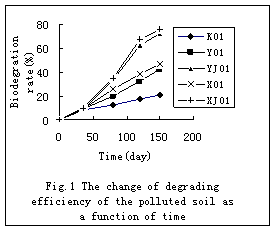
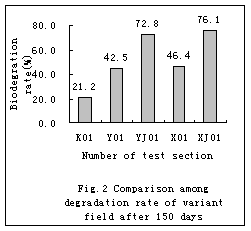
Table 3
Distribution of bacteria from soil in 140th day
|
test |
bacteria |
epiphyte |
Actinomyce |
||||
|
region |
Total |
Oil-philic bacteria |
DX-9 |
Total |
Oil-philic bacteria |
Total |
Oil-philic bacteria |
|
K00 |
3.6×105 |
2.1×103 |
|
2.3×104 |
1.8×102 |
5.6×104 |
not detected |
|
K01 |
7.1×105 |
4.5×104 |
|
7.6×105 |
3.2×103 |
4.8×104 |
1.8×102 |
|
Y00 |
6.2×107 |
3.6×103 |
|
4.1×106 |
2.8×103 |
6.1×105 |
3.7×102 |
|
Y01 |
2.8×107 |
1.9×105 |
|
5.4×106 |
7.2×104 |
7.2×105 |
4.1×103 |
|
YJ01 |
5.6×108 |
6.4×107 |
2.8×104 |
2.8×106 |
1.6×105 |
6.4×105 |
7.1×103 |
|
X00 |
9.6×107 |
4.2×103 |
|
7.2×106 |
3.1×103 |
8.1×105 |
4.2×102 |
|
X01 |
2.1×107 |
2.8×106 |
|
5.6×106 |
3.6×104 |
3.5×105 |
5.8×103 |
|
XJ01 |
4.7×108 |
5.5×107 |
6.7×104 |
2.6×106 |
5.8×104 |
3.9×105 |
5.2×103 |
From table3, it is known that the total numbers of microorganism in the areaY00, X00 are 150 times and 240 times as many as those in the control area K00 respectively. The numbers in the area Y01,X01 are 22.7 times and 18 times more than those in area K01. It means that the rhizosphere effect of corn and sunflower have improved the growth and reproduction of microorganism in soil;After the contamination of soil, the Oil-philic bacteria in soil increased in evidence,which would become more obvious under the rhizosphere effect. The reason is that after the soil contamination, the microorganism in the polluted spot can metabolize pollutant after being acclimated, the result of which is to make the pollutant which can not be transformed or has a very slow transformation rate when overflow drain occurred be metabolized and degradated. The adaptability of microorganism increases the quantities of Oil-philic bacteria [10];The addition of DX-9 makes the total amount of Oil-philic bacteria increased by 1/1000 to 4/10000. It means that DX-9 adapts the soil environment basically. It has competitive power in growth and reproduction when coexisting with the original microorganism. As it is indicated in table 1From graph1and2,Corn and sunflower have obvious remediation ability to the petroleum-contaminated soil. The degeneration rate in the 150th day reached 42.5% and 46.4% respectively, which is more than two times higher than the control area (K01). The highly efficient petroleum-degradative bacteria ( DX-9) enhances the plant biomass and improves other biocharacters, It enhanced the biomass by 10.1%, plant height by 8.2% and root weight by 11.2% in YJ01 area compared with Y01. The biomass and sunflower-plate diameter increased by 12.8% and 4.5% in XJ01 area compared with X01, while the rate of empty seeds decreased by 20.6%;The speed of biodegradation is accelerated in evidence. In the 150th day, the petroleum degradation rates in YJ01 and XJ01 test areas increased 71.3% and 64.0% respectively compared with the test areas in which the bacteria was not addedThe degradation curves in area Y01, YJ01, X01, XJ01 were analyzed through the linear regression, The results are shown in graph 3 to graph 6.It can be seen that the petroleum degradation curve accords with the equation of kinetics of first-order reaction:
-dc/dt=kc …… (1)
From(1)we could get: lnC=lnC0 –kt (2)
C is the residual
concentration of petroleum at any time(mg/L). C0 is the original concentration and k is the
velocity constant(The constant was
divided by the ground substance,d-1). The horizontal
axis is time and the vertical axis is lnC. Test points were analyzed through
the linear regression. The intercept of the straight line is lnC0 and
the slope is k. Using the values of k, the degradation rates under different
test conditions could be obtained[11] . The degradation rates
in four test areas are : XJ01> YJ01> X01>Y01.
From equation (2),
the half-time formula of petroleum degradation is obtained:
t1/2=ln2/k …… (3)
The half-time of
the degradation of petroleum in area Y01, YJ01, X01, XJ01 is 177.7d, 76.1d,
165d, and 68.6d respectively. The half-time in the area YJ01 is about 2.3 times
shorter than that in area Y01 and the half time in area XJ01 is approximate 2.4
times shorter than area X01. It means that the method using sunflower and
adding highly efficient petroleum-degradative bacteria(DX-9) has a fast
remediation rate and terrific effects.
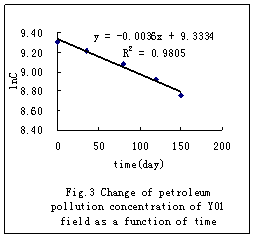
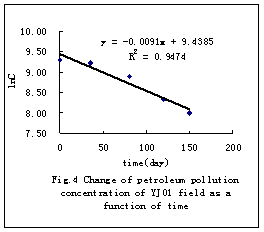
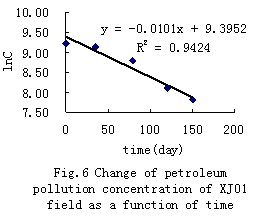
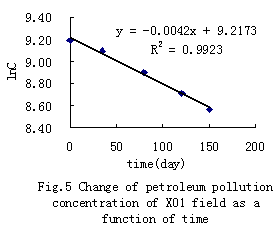
3 Conclusion:
(1) The
petroleum-contaminated soil restrains the growth of corn and sunflower. When
the concentration of petroleum contaminated soil was up to 10000mg/kg, the organism biomass was reduced by
14.5% and 21% respectively. However, under that concentration, the petroleum
didn’t have special restraints to the roots and the part over earth.
(2)The corn and
sunflower have obvious remediation function to the petroleum-contaminated
soil. The degeneration rate in the 150th day reached 42.5% and
46.4% respectively increasing 100.5% and 118.9% compared with the control areas
(3)The reinforcing
and coordinating functions of DX-9 to plant reconditioning of
petroleum-contaminated soil were also obvious. The degradation rates
in areaYJ01 in the 150th day is 72.8% ,increased by 71.3%
compared with control area Y01 and the rate in area XJ01 is 76.1% ,increased by
64% compared with area X01 .
(4) Under the
conditions of field test, the degradation curve accords with the equation of
kinetics of first-order reaction. The degradation rates are: XJ01> YJ01 >X01 >Y01 and the half-life of the
petroleum hydrocarbons were 68.6d,76.2d,165d, and 177.7d respectively. The effect of the technology of
DX-9 corn(or sunflower) reconditioning on petroleum-contaminated
soil is good.
(5) The residuum
of petroleum hydrocarbon in plant needs a further study.
References:
[1] LI Cai-feng,WEN Qing,XIA Shu-mei. The Bioprocess Technology of the Petroleum-contaminated
Soil [J]. Applied Science,2000,29(10):62-64.
[2] REN Lei,HUANG Lin. The Bioremediation Technology of
Petroleum-contaminated Soil [J]. The Transaction of Safety and Environment,2001,1(2):50-54
[3] LU Xiu-jun, GUO Shu-hai, SUN Qing etc. The Present State and
Perspectives of the Study of Remediation of Petroleum-contaminated Soil [J].
The Transaction of Shenyang Agriculture University, 2003, 34 (1)
:63-67
[4] ZHENG Xi-lai, LIU
Xiao-yi, XI Lin-ping. The Study of the Retarded Effect of the Adsorption of
Porons Medium on the Transportation of Petroleum Contamination [J]. The
Transaction of Changchun University of Science and Technology,1999,29(1):52-54
[5] CUI Liang-ji,
LIANG Guo-zhan, WANG De-xing The Relations between the Photosynthetic
Performance and Self-cross Yield under the Condition of Summer Seeding[J]. The
Transaction of Chinese Oil Bearing Crops,2002,24(1):48-50
[6] LIANG Guo-zhan,
CUI Liang-ji The Breeding Selection of self-cross knocks the food to
break down sunflower and its main Characters [J]. The Liaoning Agriculture
Science,1995,6,13-16
[7] ZHENG Ai-jun, SONG
Hai-tao, LI Jie. The Reasons, Prevention and Cure of the Increase of Empty
seeds in Sunflower[J]. The Science and Technology of Agriculture and Forestry
in Tianjin,2002,4,7-8
[8] SHEN Ping, FAN
Xiu-rong, LI Guang-wu. The Experiments of Microorganism [M] Peiking:Higher education publication,2002,69-94
[9] DING Ke-qiang,
ZHENG Zhao-pei, SUN Tie etc. The Study of Biodegradation of
Petroleum-contaminated Soil [J]. The Magazine of Bionomy, 2001,20(6):16-18
[10] ZHOU Qi-xing, SONG
Yu-fang, DING Ying etc. The Principle and Method of the Remediation of
Contaminated Soil [M]. Peiking:Science publication,2004,212-232
[11] ZHANG Xu, LI
Guang-he, HUANG-Wei. The Study of Simulated Experiment of the Bioremediation of
Petroleum Hydrocarbon Contaminated Soil [J]. The Transaction of Qinghua
University, (the Edition of Natural Science),2000,40(11):106-108




